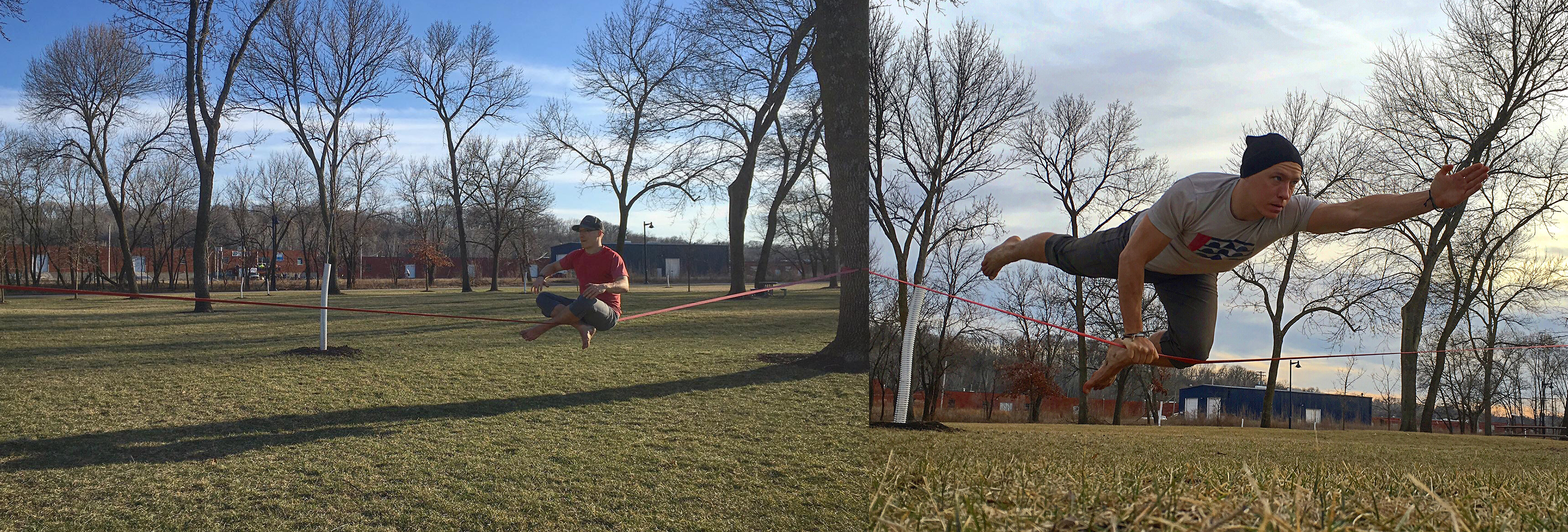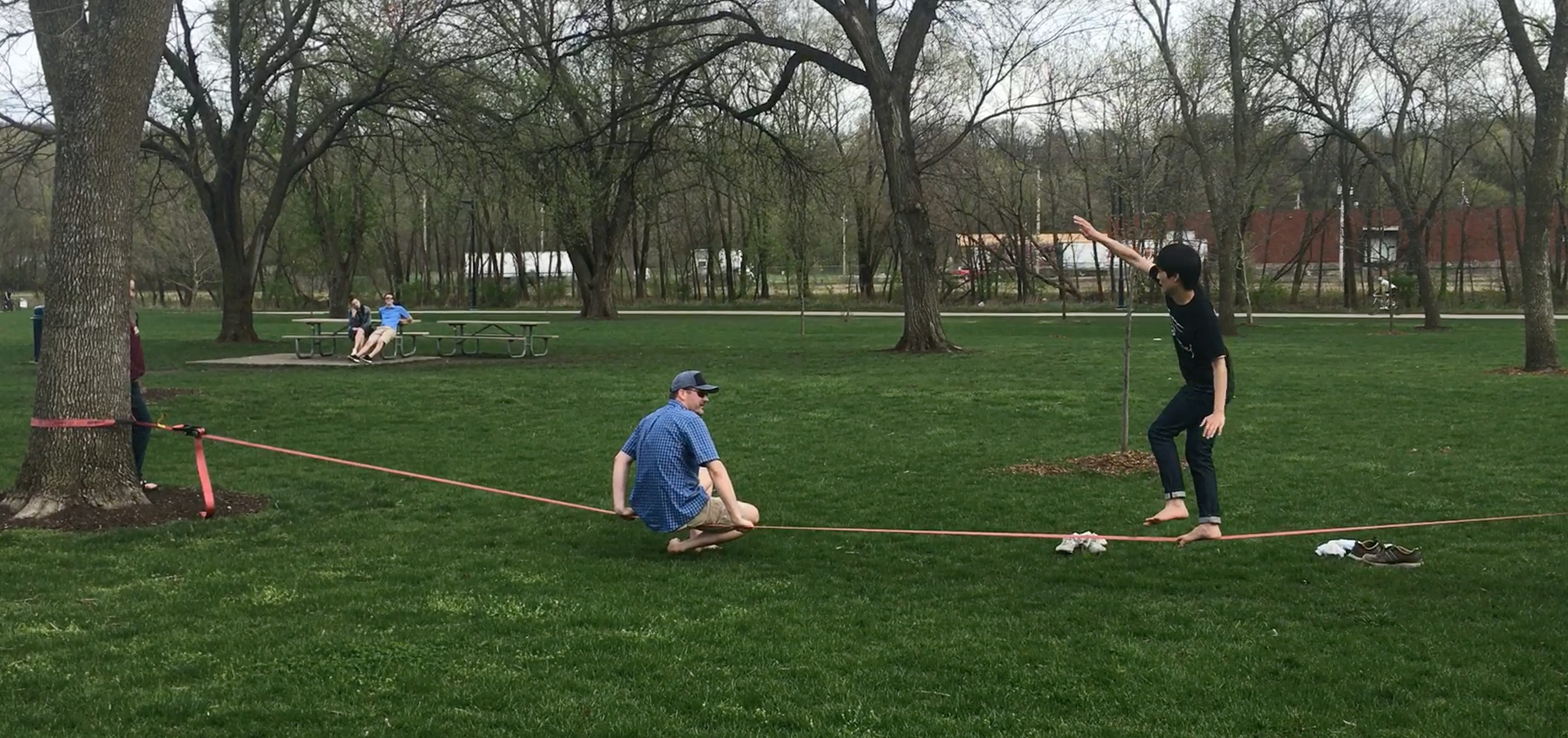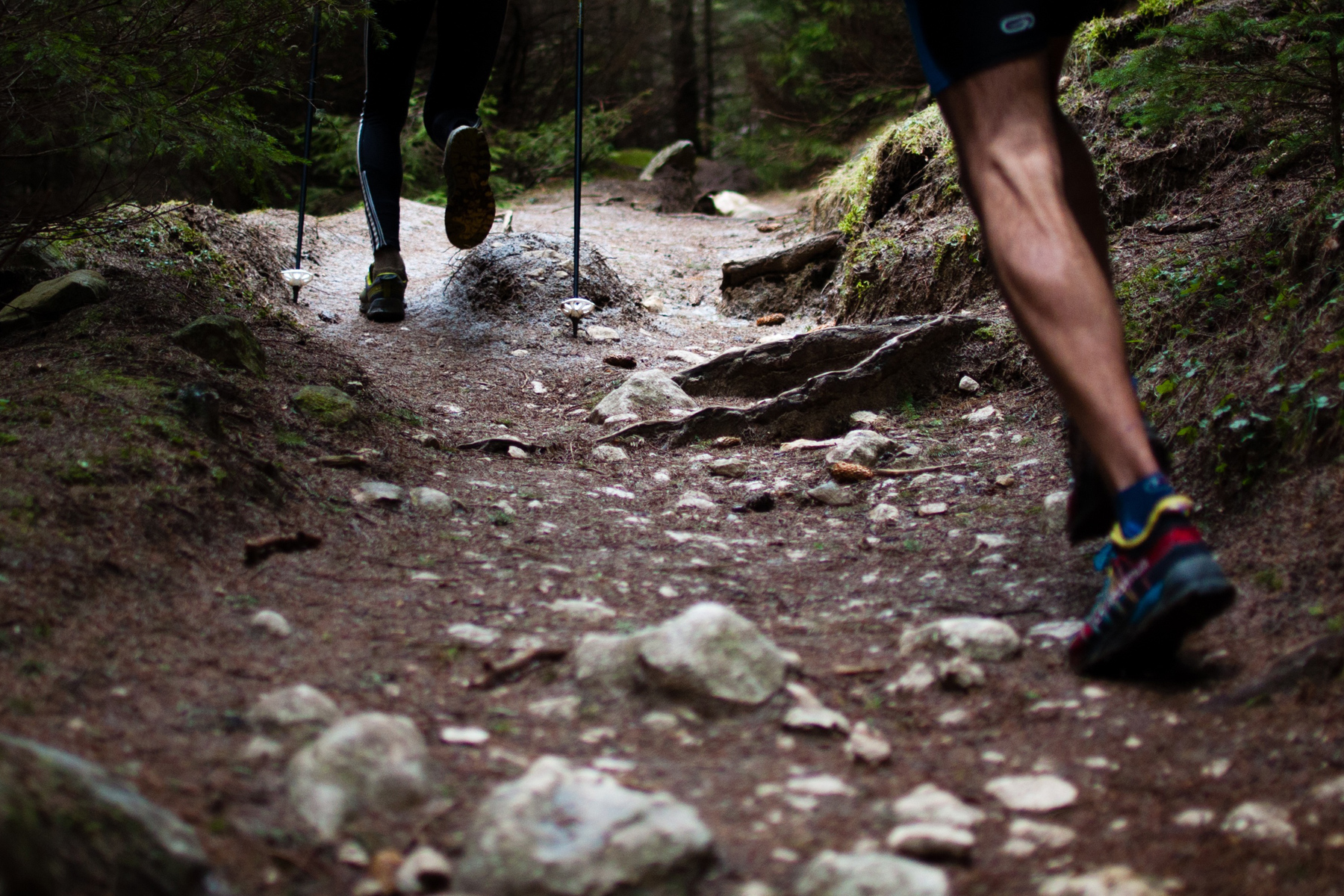Written by Active Endeavors Ambassador, Calvin Johanssen
Introduction To Slacklining: The Perfect Activity To Perfect Your Balance
One of my favorite ways to pass time in Des Moines, is to walk a line strung between trees. I never knew that such a simple concept could be so challenging, addicting and rewarding. Welcome to the world of slacklining.
Often times when I’m setup down at Gray’s Lake, it’s not uncommon for people to gaze in wonderment of what this “thing” is. It never fails, that I have at least one – but usually a handful – of people come up to me, and want to try to walk the line. These moments may just bring me a greater sense of joy than actually walking the line, because it means I’ve piqued their curiosity, and hopefully have given slacklining a new raving fan. The same thing that happened to me a few years ago.
This activity is popular amongst climbers, and outdoor enthusiast. It will test your balance and mental limits. Whether you’ve never heard of slacklining, or have seen it once or twice, I want to give you the rundown of this activity. Let’s begin with what slacklining is.

WHAT IT IS
Slacklining – in it’s simplest form – is a piece of webbing strung between two points. A beginner’s line may be anywhere from 20ft to 80ft long, only one-to-three feet above the ground, and either one or two inches in width. A Slacker (term for someone on the line) will test their balance by either standing on the line, or by trying to walk across the entire line without falling. As someone gets more comfortable on the line, they typically lengthen the line (ie: find two trees that are farther apart to set up) to make the activity more difficult. This is more challenging because the longer the line, the less tension it will have, therefore making the line sway more.
Once someone has perfected the ability the walk across the line multiple times, they will usually progress to tricklining, or highlining. Tricklining, is the extreme sport version of slacklining, where people bounce on the line to do various tricks, such as flips. Simple beginner tricks are either drop knees, chest bounces, or bouncing on your butt to your feet.
Highlining, which resembles tight-rope walking, is when a slackline is strung-up very high in the air. Normally this happens across canyons. While this looks terrifying and dangerous, it’s quite safe because the Slacker wears a harness to be tethered to the line. This way if they fall, they stay attached to the line (similar to rock climbing). Highlining amps the mental game up to 100. Although the best advice I’ve been given is that, “if you can walk it in the park, you can walk it in the air”.
HOW IT WORKS
Going back to the moments when I’m approached in the park, it’s because someone wants to to try slacklining, in which I’m eager to teach. At first I sit back and let them do their thing, with no backseat coaching. I do this because I’m a big believer that experience is the best teacher — so that they can understand just how difficult slacklining is. And perhaps I enjoy a good chuckle.
After a couple failed attempts at standing, I’ll begin giving advice. The two most important tips are to breath, and focus. I have someone pick out a focal point on the tree, instead of staring at their shaky feet, and give them the reminder to breathe, and breathe often. The moment you hold your breath, you’ll tense up, and fall off the line. Next… I repeat a thousand times that you have to crawl, before you can walk. In this case, you must be able to stand before you can walk. Too often, a newbie will jump on the line with the intention of sprinting across it. Quickly their dreams will crash and burn.
Thinking back to my first day on the line… I spent about three hours just trying to stand up in one spot for fifteen seconds. And it was an ugly fifteen seconds. Then a couple weeks later I was able to walk across the line, after putting in another dozen hours of practice.
You’re probably wondering, “what makes standing and walking a piece of webbing so difficult?”. The answer lies in our micro-stabilizer muscles. The most common question I get, when someone places their foot on the line in preparation to stand up is, “How do I get this line to stop shaking?”
I smile and say, “Well… Actually the line isn’t moving. You’re moving the line.” It’s the best philosophical response I’ve come up with, and it’s quite true. When you first begin slacklining, your micro-stabilizer muscles have to adapt and develop. We spend 99% of our life on solid ground, whereas this line isn’t so solid. So our lack of success to walk the line in our first few attempts isn’t due to some mental block, it’s due to lack of muscle fibers – a physiological limitation. So not only do you need time to learn the skills to balance, but your body needs time to develop.
Back to the advice I give for standing on a line for the first time… Be a “wet noodle”. I share this tidbit to remind people to not be so tense. You want your limbs to be able flow and adjust to counterbalance yourself. Trust your body… As your limbs will magically move to the right spot to find balance. Once you’re able to stand on one foot, I have them step and switch feet to balance on the opposite foot.
One key to first learning slacklining is to learn on a short line, because it’ll be more taught and easy to walk. So no matter the length I have setup, I’ll sit down on the line to make it more taught. Basically I become the anchor, instead of the tree. With a tighter line, people have success much quicker and get the experience of standing in a few seconds, instead of the discouragement of not being able to stand at all.
My goal is to have them walk away feeling like a winner, and wanting to do slacking, instead of never trying again.

WHY I SLACKLINE
Hopefully by now you have a little understanding of what slacklining is, and how it works. To wrap up this introduction, I want to leave you with a little understanding of why I choose to embrace this awesome sport, and why I’m such an advocate to exposing others to it.
For me, there are two primary benefits, one being mental, and the other is physical. I find slacklining to be a great form of moving meditation. It forces me to be 100% present, allow me to forget about any other thoughts, or worries. It’s a similar feeling to when I go trail running. Because the moment my mind wanders – in either scenario – I’ll faceplant. Also it’s a great excuse to get outside and enjoy parks around town.
For physical benefits, I see it as a form of injury prevention because of the development of micro stabilizers in all my joints, preventing me from easily rolling an ankle and putting me on crutches. I’m confident this activity is greatly helping my other hobbies of climbing and handstands.
After a session, my core, legs, and arms are on fire, because they’ve been engaged for so long. It’s a similar feeling to yoga. Speaking of… another world to explore with slacklining is Slackline Yoga, very similar to doing yoga on a stand-up paddle board. It’s the next level to your practice. Like any activity or sport, once you begin, you realize how deep the rabbit hole goes.
What began as a step of curiosity a couple years ago, has turned into a weekend passion. I’ve progressed passed a starter line of 2-inch width of 50ft, to working with a one-inch width line of up to 250 feet. Right now my current project is walking 80 ft of one-inch line, in preparation to tackling my summer goal of highlining across a canyon this summer.
OPPORTUNITY TO LEARN
If you’d like to learn more about slacklining, from taking your first step, to setting up your first line, then I invite you to join me at the “Slackline 101” session that I’m facilitating with the Active Endeavors Field Testing Gear Event at Jester Park this Saturday, May 6th from Noon-5PM. The slackline portion will happen at 1PM.
If you happen to see me down at Gray’s Lake in Des Moines, then don’t be a stranger. Came say hi, and take a shot at walking the line.
RESOURCES (VIDEOS)
This collection of videos shows you the potential of slacklining. They cover everything from the basics, to the “impossible”. Enjoy.
- Basics of Slacklining: Slacklining Basics with Mark Sisson (Basics of Slacklining)
- Trickline Slackline Competition: 2016 GoPro Mountain Games Slackline Highlight Reel
- Slackline Highline Example: Step Out – Highline Slackline in Hawaii
- The World Record Highline (1/3 Mile!): The Zeus Highline – Full Version
- Yoga On Slackline: A Transformational Journey – Slacklining with Kendra Charts



